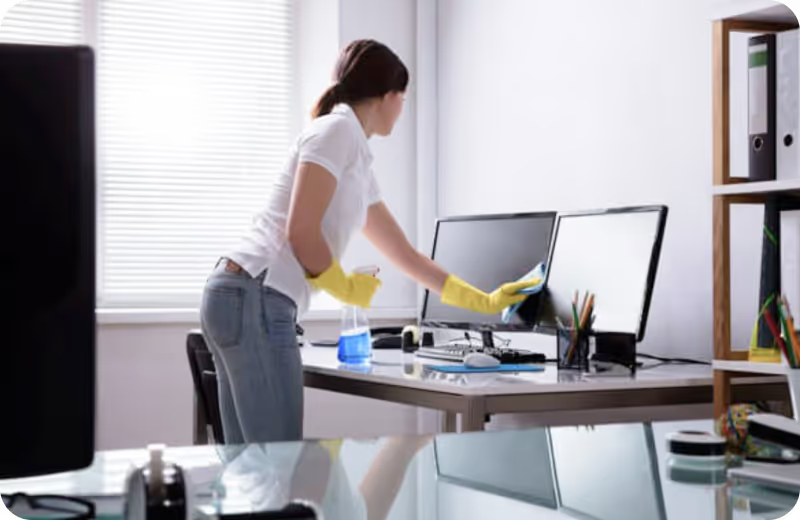
What's the filthiest spot in your bathroom? If you think it’s the toilet bowl, then you think the same as the majority of homeowners. It makes sense that the toilet bowl is the dirtiest area in your bathroom, as the toilet is where we expel our bodily wastes.
As gross as it may sound, organic waste is the favourite source of food of mold and mildew. Mold is a common issue in many homes, particularly in the bathroom where the environment is humid, and plenty of organic material are available for spores to feed on. Everything from bodily waste, to the soap you use to clean the toilet are smorgasbords for mold and mildew.
In this guide, we’ll show you different ways to remove mold and mildew in toilet bowl and around the rim, as well as the toilet tank and exterior of the toilet.
What Causes Molds and Mildew?
Mold and mildew grow in locations that are dark, damp, and with plenty of organic materials to feed on. Mold colonies start off as spores that are invisible to the naked eye, and latch onto suitable surfaces. With enough time and resources, mold and mildew can quickly grow in colonies, spreading around the home.
Cleaning toilet mold is incredibly important, as one of the black mold species that grows quickly in submerged water environments is toxic black mold, Stachybotrys chartarum, which is usually found in soil and crops. If you suspect you have toxic black mold, do not attempt to clean the mold yourself. Instead, look for a reputable cleaning service to tackle the black mold.
Constant Moisture
Moisture is the number one requirement for a mold or mildew colony to start growing. Every living thing needs to stay hydrated, and for mold, water is the key to growing in numbers. The constant moisture around your toilet bowl, and in the toilet tank, create perfect environments for nurturing the growth of mold and mildew.
Although we cannot fully remove the water in our toilet bowl and the toilet tank, we can ensure mold does not stick to the surface by maintaining a consistent cleaning schedule to remove mold spores as they latch onto the toilet.
Grime Buildup
Toilets that have not been used in a long time, or toilet bowls that are not cleaned properly, can accumulate dust, dirt, and grime that float in air. The grime buildup often contains organic material, like hair, dead skin cells, cellulose from wood and fibrous materials, and plant matter. Mold and mildew feed on these materials, and when left untouched, grow in numbers.
With grime in the toilet, you will most likely find mold in your toilet as well. The key to preventing grime buildup is to frequently clean your toilet bowl and toilet tank. Using cleaning solutions that contain long-lasting antimicrobial ingredients is convenient for homeowners who don’t like or don’t have the time to clean the toilet.
Infrequent Cleaning
Infrequent cleaning, or not cleaning your toilet properly, is the number one reason for mold in the toilet. The toilet sees a great deal of wastes daily, which results in bacteria, germs, and mold in your toilet. You will need to clean the toilet frequently to avoid getting sick from the germs that grow around the bowl and tank, as well as to get rid of mold that may bring allergies.

How to Remove Mold and Mildew in the Toilet Bowl
A toilet brush can do wonders for removing mold in your toilet, but a thorough and frequent cleaning makes sure that they don’t return. Here are a few tips and tricks on how to get rid of mold from your toilet bowl and tank:
The Commercial Way
Plenty of commercially available cleaning products on the market are formulated to get rid of mold in the bathroom, including the toilet. There is a variety of products, from liquid to gel solutions, and even powders you can place in the toilet tank for general upkeep.
Reach for any of these suitable products, and follow the manufacturer’s instructions on how to use the product. Use a spray bottle to get beneath the rim, and scrub well with a brush. Flush the toilet once cleaned to wash away any remaining particles.
The Chlorine Bleach Method
Chlorine, like the ones used for swimming pools, is a powerful cleansing agent that kills mold on contact, leaving your toilet sparkling white again. Chlorine bleach, the kind you find in the laundromat, makes for a strong disinfectant that does not only kill germs and bacteria, but mold and mildew colonies as well.
Place a cup of bleach into the bowl, and use the toilet brush to swirl the liquid around, making sure to cover the entire surface, including underneath the rim where mold typically grows. Add a cup of bleach into the tank as well, and scrub in a similar fashion using a scrub brush or sponge. Let the bleach sit for 20 minutes. Reapply another cup of bleach to the tank and bowl if needed.
Once you’ve cleaned the bowl, flush the toilet to rinse off any remaining mold particles. This method removes all kinds of green, brown, and black mold, including the non-toxic species of black mold that usually leaves a stain on the surface.
The Vinegar and Baking Soda Method
Both distilled white vinegar and baking soda are effective against mold. Sprinkle a generous amount of baking soda all over the bowl, spreading a layer over the entire surface. Add in a cup of vinegar to the toilet basin, and allow the solution to fizz. Let the solution sit for 10-15 minutes, and use a toilet brush to scrub away the grime and dead mold.
After the allotted time has passed, flush the toilet to wash away the particles before using. Apply a spray of vinegar around the rim, and beneath it to ensure that mold won’t regrow in these areas. Do the same to the tank, and keep the spray on hand for general cleaning.
The Convenience of Professional Cleaning
Don’t like cleaning toilets? No problem! A professional home cleaning service Singapore should be able to tackle the cleaning for you at a modest price. You won’t have to worry about toilet mold ever again when you’ve got a part-time or full-time maid service to ensure your bathroom is sparkling clean!
At Luce, we take pride in what we do: we clean your home from top-to-bottom, making your house spotless. You won’t need to worry about dust or grime, just enjoy the clean comfort of your space. Give us a call today and let’s schedule an appointment that works for you!


























